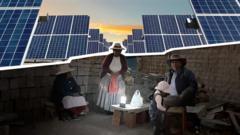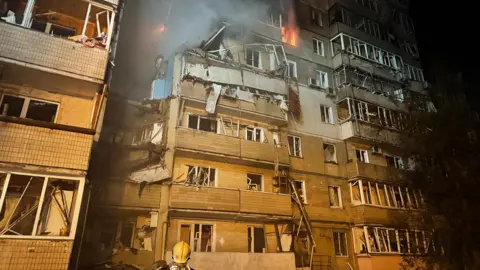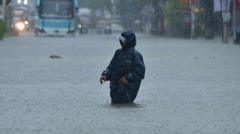In the small village of Pampa Clemesí, nestled in the southern regions of Peru, the residents begin their days with the faint glow of flashlights, an ironic juxtaposition to the abundant sunlight powering the Rubí solar complex nearby. With an extensive setup featuring 800,000 solar panels, installed between 2018 and 2024, this solar plant is touted as the largest in the country and ranks among the most significant in Latin America.
However, while the plant functions optimally, its adjacent community of 150 individuals still remains disconnected from the national power grid, leading to a striking scenario where the daily lives of these residents are illuminated only occasionally by borrowed light. "Every day I rely on others to charge my phone," shares Rosa Chamami, a local struggling with the absence of electricity, as she endeavors to stay in touch with family across the Bolivian border.
Most villagers have access only to solar panels gifted by the plant's operator, Orygen, but the costly installation of batteries and converters renders them nearly useless. Ironically, the Rubí plant generates approximately 440 GWh annually, capable of serving over 350,000 households. Despite Peru's renewable energy boom and the region's accolade of maximized sunshine (over 3,200 hours each year), many communities still lag in electrification, while development appears profit-driven and neglects isolated settlements.
Orygen asserts it has fulfilled its commitment to the village, claiming to have constructed 53 power towers and laid nearly 4,000 meters of cable to connect Pampa Clemesí to the grid. However, the task of linking each home remains unaddressed by the Ministry of Mines and Energy, as locals await the promised implementation, originally slated for a 2025 start. Attempts to reach ministry representatives have gone unanswered.
As darkness envelops the village each night, residents resort to cooking over fires or inexpensive gas stoves; many do not have refrigerators and thus face daily struggles to preserve perishable items. Consequently, dinners are shared among neighbors under solar-powered lanterns, a bittersweet reminder of their potentially brighter reality. Despite their plight, some residents cling to hope for the future; Pedro Chará, a local elder, mourns the loss of neighbors who departed due to inadequate infrastructure. "Without light, we cannot build a future," he laments.
Every evening, Pampa Clemesí's inhabitants gather beneath a canopy of stars, sharing prayers and hopes for lasting changes, but lamenting the persistent shadows cast upon their lives by an energy-rich neighbor that seems all but unreachable. Each sunset signifies another night of uncertainty, yet the community remains resilient — tethered to the unwavering sun that shines above them, but continues to leave them in the darkness of disconnection.



















